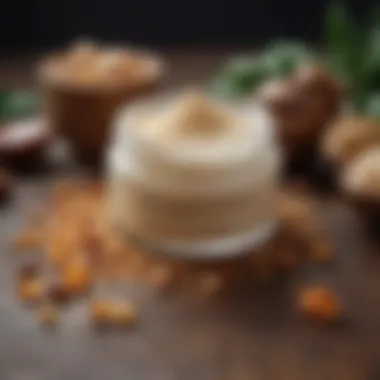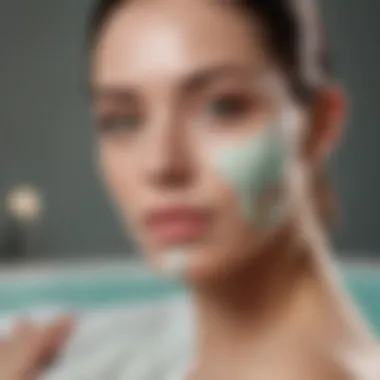The Essentials of Moisturizing Scrubs for Skin Care


Intro
In recent years, the skincare realm has embraced a myriad of innovative products, one of which is the moisturizing scrub. This unique blend of exfoliation and hydration plays a crucial role in modern skincare routines. An effective moisturizing scrub not only removes dead skin cells but also infuses the skin with essential moisture. The outcome is a radiant and healthier appearance, suitable for women of all ages.
Understanding what these products are, how they work, and the best ways to incorporate them into one’s routine is vital. This article aims to provide comprehensive insights into the essentials of moisturizing scrubs. We will explore their significance, the ingredients that enhance their impact, and share effective application techniques. Additionally, we will address common pitfalls to avoid and the overall contribution of these scrubs to skin health.
It is essential to delve into the specifics to grasp how these scrubs excel in delivering results. Sound knowledge allows for informed choices, ensuring that individuals can maximize the benefits of their skincare investments.
Intro to Moisturizing Scrubs
In the realm of skin care, moisturizing scrubs have gained notable attention for their dual action of exfoliating and hydrating the skin. This introduction serves as a foundation to understand the essential role of these products in a comprehensive skin care regimen. Moisturizing scrubs do not just cleanse the surface of the skin; they also aim to enhance overall skin health.
One of the primary benefits of moisturizing scrubs is their capability to remove dead skin cells. This exfoliation process allows for newer, healthier skin to emerge. In addition to removing impurities, the moisturizing element helps to replenish the skin's moisture barrier. As a result, users can achieve a smooth and supple surface that is both vibrant and resilient.
Moreover, the versatility of moisturizing scrubs makes them appealing to a wide audience. Available in numerous formulations, they cater to different skin types and concerns. This article will elucidate their various forms, highlighting ingredients, benefits, and application techniques that will allow users to make informed choices when integrating these products into their routines.
Definition and Purpose
Moisturizing scrubs can be defined as skincare products designed to exfoliate and hydrate the skin simultaneously. They typically combine physical exfoliants, such as sugar or salt, with moisturizing agents like oils or creams. The purpose of using these scrubs is to promote skin renewal through exfoliation while preventing dryness which may occur post-exfoliation.
Individual ingredients lend varying properties to the scrubs, enabling tailored solutions for different skin concerns. For example, if a product primarily contains natural oils, it may be particularly beneficial for dry skin types. Conversely, those with oily skin might prefer formulations with lighter textures and specific active ingredients.
Historical Context
The practice of scrubbing the skin is not a modern concept. Throughout history, different cultures have adopted various methods for exfoliation and cleansing. Ancient Egyptians used sand and oils, while traditional Chinese methods integrated herbs and natural exfoliants. This historical backdrop emphasizes that the desire for clean and vibrant skin has been a long-standing pursuit.
In contemporary society, the formulation of moisturizing scrubs has evolved significantly. Advances in cosmetic chemistry have enabled more sophisticated blends that enhance efficacy. New ingredients are regularly discovered and optimized for skin benefits. Today, moisturizing scrubs are often included in a broader approach to skincare, reflecting a growing understanding of skin health and self-care.
Benefits of Using Moisturizing Scrubs
Moisturizing scrubs play a vital role in skin care by blending exfoliation with hydration. Many women are unfamiliar with the transformative effects that these products can provide. Understanding these benefits enhances the appreciation for integrating moisturizing scrubs into daily skincare routines. This section highlights fundamental advantages that establish the necessity of moisturizing scrubs for every individual aiming for healthier skin.
Exfoliation and Hydration
The primary benefit of using moisturizing scrubs is their ability to exfoliate while simultaneously hydrating the skin. Exfoliation clears away dead skin cells that accumulate on the surface. This process allows for new skin to emerge, resulting in a fresher appearance. Hydration from oils and other moisturizing ingredients in the scrub nourishes the skin. A well-formulated scrub balances exfoliation with hydration, avoiding potential dryness or irritation.
"Effective exfoliation can renew skin and support moisture retention, fundamental for healthy skin."
Regular use of moisturizing scrubs can lead to smooth and radiant skin. This improves the texture and tone, giving the face and body an even appearance. Many people notice that their skin feels softer and more supple after exfoliating, which boosts confidence.
Skin Renewal and Texture Improvement
Moisturizing scrubs encourage skin renewal. When dead skin cells are removed, the skin's regeneration process speeds up. This renewal leads to a brighter, more youthful appearance. Furthermore, scrubs can improve the texture of the skin significantly. Rough patches or uneven areas become less prominent, creating smoother skin overall.
For those with concerns like dullness or uneven skin tone, incorporating moisturizing scrubs regularly can help. With continuous use, individuals may see a marked improvement in skin clarity and smoothness.
Enhancing Other Skincare Products
Moisturizing scrubs do not only serve their immediate purpose; they also enhance the effectiveness of other skincare products. When the surface layer of dead skin cells is eliminated, serums, oils, and creams penetrate deeper. This results in better absorption of nutrients and active ingredients. Consequently, moisturizing creams and other products work more effectively when used following a scrub.
To maximize the benefits of a skincare regimen, consider using a moisturizing scrub before applying topical treatments. This may lead to better outcomes and a more satisfying skincare experience.
Key Ingredients in Moisturizing Scrubs
The importance of key ingredients in moisturizing scrubs cannot be overstated. These components are essential for achieving the desired outcomes in skincare. They can determine the effectiveness of the scrub in exfoliating and hydrating the skin simultaneously. By understanding these ingredients, one can make informed choices that lead to better skin health and enhanced radiance.


Exfoliants: Types and Functions
Exfoliants serve the primary role of removing dead skin cells, thereby revealing fresh skin underneath. There are mainly two types of exfoliants: physical and chemical.
Physical Exfoliants
Physical exfoliants are tangible particles that physically scrub the skin's surface. Common materials used include sugar, salt, and coffee grounds. The key characteristic of physical exfoliants is their immediate effect; they provide instant results in terms of smoothness and softness. Their beneficial choice lies in the hands-on engagement, allowing users to feel the scrubbing action directly.
A unique feature of physical exfoliants is that they can be tailored easily. For example, one can adjust the coarseness of the exfoliant based on personal preference or skin sensitivity. However, there are some disadvantages. If overused, they can lead to micro-tears in the skin or irritation. Therefore, moderation is essential.
Chemical Exfoliants
Chemical exfoliants use active ingredients to dissolve the bonds holding dead skin cells together. Ingredients like alpha-hydroxy acids (AHAs) and beta-hydroxy acids (BHAs) are common in this category. The key characteristic of chemical exfoliants is that they penetrate deeper than physical exfoliants. They offer more even exfoliation, making them highly effective for diverse skin types.
Their unique feature is the ability to address specific skin concerns, such as acne or hyperpigmentation. However, they may cause chemical burns or irritations if used improperly. It's crucial to follow the guidelines given and introduce them slowly into a skincare routine.
Moisturizers: Best Ingredients
Including effective moisturizers in scrubs enhances the overall skin conditioning aspect. Moisturizers help to hydrate and protect the skin post-exfoliation, sealing in moisture.
Natural Oils
Natural oils, such as coconut oil or almond oil, are indispensable in moisturizing scrubs. They provide a hydrating layer that complements the exfoliation process. What makes natural oils a beneficial choice is their rich fatty acid content that keeps the skin nourished and supple.
A unique feature of natural oils is their ability to cater to various skin concerns, including dryness or wrinkle formation. Though they are very beneficial, they sometimes can make skin feel greasy for some individuals, requiring balance in formulation.
Humectants
Humectants like glycerin and hyaluronic acid play a critical role in keeping the skin hydrated. Their main function is to attract moisture from the atmosphere into the skin. This makes humectants a popular choice for skincare formulations, as they help maintain skin hydration levels effectively.
Their unique feature is their ability to provide hydration without the added oiliness that some natural oils may possess. However, it may be less effective in dry environments where moisture is limited. Understanding the balance of such ingredients is essential for maximizing their benefits.
Additives for Enhanced Benefits
To further boost the efficacy of moisturizing scrubs, certain additives can be introduced into the formulations.
Vitamins
Vitamins like E and C are celebrated for their antioxidant properties which help protect skin from environmental damage. Their inclusion in scrubs enhances the nourishing aspect, making them a popular choice for providing skin elasticity and brightness.
A key characteristic of vitamins is how they aid in skin repair and rejuvenation. However, sensitivities to certain vitamins can occur, making it worthwhile to patch test before regular use.
Botanical Extracts
Botanical extracts, like green tea or chamomile, offer additional calming properties. Their role lies in providing anti-inflammatory benefits that are invaluable for sensitive skin types. The key characteristic of these extracts is their natural origin, appealing to a growing audience prioritizing organic ingredients.
The unique benefit of botanical extracts is the variety they bring, catering to different skin needs. However, sourcing quality ingredients is essential; lower-grade extracts might not provide the expected benefits.
DIY Moisturizing Scrub Recipes
Creating your own moisturizing scrubs is not only cost-effective but also allows for customization according to your skin's specific needs. The importance of DIY moisturizing scrub recipes lies in their potential to cater to diverse skin types and preferences. With access to natural ingredients, users gain the advantage of avoiding some of the harsh chemicals found in commercial products. Moreover, DIY scrubs can enhance the user’s connection to their skincare routine, fostering an understanding of what is applied to the skin. This results in a more informed approach towards skin health, providing a sense of satisfaction and empowerment.
Simple Recipes for Beginners
Brown Sugar and Coconut Oil


The combination of brown sugar and coconut oil creates a gentle and effective scrub. Brown sugar has small granules, making it a suitable exfoliant for sensitive skin without causing irritation. It provides mild exfoliation, helping to slough away dead skin cells while promoting new cell growth. Coconut oil, on the other hand, is known for its moisturizing properties. It is rich in fatty acids, which help to hydrate and nourish the skin.
This mixture is popular because it combines exfoliation with hydration in one step. The unique feature of brown sugar is its natural glycolic acid content, which can help to improve skin texture. The main advantage of this recipe is that it is easy to prepare and use, requiring only two ingredients found in most kitchens. However, individuals with nut allergies should be cautious with coconut oil.
Coffee Grounds and Honey
This dynamic duo of coffee grounds and honey offers a unique approach to skin exfoliation. Coffee grounds provide a robust texture that not only removes dead skin cells but also increases blood circulation when massaged onto the skin. This can result in a more refreshed appearance. Honey is a natural humectant, attracting moisture to the skin, and possesses antibacterial properties which can aid in reducing acne.
The key characteristic of this scrub is its energizing scent and texture. Many find this an inviting choice for their routine. The unique feature of using coffee grounds is their ability to wake up the skin, combined with honey’s soothing effect. One advantage of this scrub is that it leaves the skin feeling soft and hydrated. Nevertheless, care should be taken to avoid using coffee grounds on sensitive areas that may require a gentler touch.
Advanced Recipes for Enthusiasts
Sea Salt and Almond Oil
For those experienced with DIY scrubs, a sea salt and almond oil combination might be appealing. Sea salt is a powerful exfoliant that removes dead skin and impurities effectively. It can promote better product absorption in subsequent skincare routines. Almond oil complements sea salt by adding hydration, bringing softness to the skin.
The key characteristic of this scrub is its balance between exfoliation and nutrition. This makes it favorable for individuals seeking a deeper clean along with moisture. The unique feature of this combination is the rich vitamin E found in almond oil, which can help to diminish the appearance of scars. While this recipe is effective, users should be mindful not to apply it too often, as over-exfoliating can irritate the skin.
Oatmeal and Jojoba Oil
A scrub made from oatmeal and jojoba oil represents a gentle, soothing option for those with sensitive or dry skin. Oatmeal serves as a natural exfoliant, calming inflammation and irritation. It also absorbs excess oil, making it versatile for various skin types. Jojoba oil mimics the skin's natural oils and is known for its hydrating properties.
The combination is highly regarded for its soothing effects and ability to nourish the skin. One of the unique features of oatmeal is its anti-inflammatory properties, which can aid in reducing redness. Additionally, jojoba oil helps to maintain skin balance, preventing dryness whilst providing moisture. This recipe’s advantage lies in its minimal irritation, making it suitable for frequent use. Nonetheless, those with allergies to grains should carefully assess their sensitivity before use.
"Making your own scrubs can be an effective way to tailor skincare to your individual needs while ensuring higher ingredient quality."
The DIY approach then results in versatile options that reflect personal preferences and skin requirements, enhancing overall skincare experiences.
How to Use Moisturizing Scrubs Effectively
Using moisturizing scrubs effectively can greatly enhance their benefits. It is essential to understand how to integrate them into a skincare routine. This involves looking at the right frequency of use and the specific areas of application. Learning these techniques can lead to better skin health and improved texture.
Application Techniques
Frequency of Use
The frequency of using moisturizing scrubs is one of the most critical aspects of an effective routine. Over-exfoliation can occur if they are used too often, leading to irritation and sensitivity. Most dermatologists recommend using moisturizing scrubs about 1 to 3 times a week, depending on your skin type. For instance, those with oily skin might benefit from a more frequent scrub, while dry or sensitive skin may require less frequent applications.
This balanced approach ensures that the skin receives necessary exfoliation but also retains moisture. The unique feature of this frequency is its adaptability; individuals can adjust based on their skin’s needs and reactions. The beneficial outcome is smoother skin with fewer dead cells obstructing the natural radiance of the skin.
Areas of Application
Knowing the appropriate areas for applying moisturizing scrubs is crucial for achieving targeted results. Moisturizing scrubs can be applied to various parts of the body, but focus should be on areas that might need extra care, such as elbows, knees, and face. The facial skin is delicate, and selecting a gentle scrub is important here. On the other hand, thicker scrubs work well for body parts like legs and arms.
A key characteristic here is the versatility of application. While some might think scrubs should only be for the face, they can enhance the overall skin appearance on other areas too. The advantage of this is that it promotes an even skin tone, preventing rough patches which are common in these areas.
Post-Scrub Skincare Routine
After the application of a moisturizing scrub, an appropriate skincare routine is necessary. This step often includes applying a hydrating serum or cream to seal in moisture and nourishment. Products containing hyaluronic acid or glycerin work particularly well as they draw moisture to the skin. This seals the benefits of the scrub, ensuring long-lasting hydration.
It is vital to allow the skin to calm down after scrubbing. Following up with soothing agents, such as aloe vera or chamomile lotion, can help prevent irritation. Overall, a consistent post-scrub routine can help maintain the achieved results and ensure your skin stays healthy and radiant.
Common Mistakes to Avoid
Understanding the common mistakes can greatly enhance the effectiveness of moisturizing scrubs in your skincare routine. Although these products provide significant benefits, misusing them could lead to adverse effects. It is crucial to identify and rectify these errors to maintain healthy skin and maximize the potential improvements that moisturizing scrubs can offer.


Over-Exfoliation Risks
Over-exfoliation is one of the primary pitfalls in using moisturizing scrubs. Scrubs are designed to remove dead skin cells and promote new cell growth. However, using them too frequently can strip the skin of its natural oils. This may result in irritation, redness, and even enhanced oiliness as the skin attempts to compensate for lost moisture.
It is generally recommended to limit scrub usage to about one to three times a week, depending on your skin type. Individuals with sensitive or dry skin should be particularly careful, as they may experience irritation more quickly than others.
"Listening to your skin is vital. Adjust your scrub routine if you notice irritation or discomfort."
Ignoring Skin Type Considerations
The effectiveness of moisturizing scrubs is significantly influenced by skin type. Failing to account for unique skin characteristics can lead to unsatisfactory results or worse skin conditions. For oily skin, a scrub with sharper exfoliants may provide better results, while sensitive skin types might require gentler, more hydrating ingredients.
It is essential to choose the right formulation that aligns with your skin’s needs. Products designed for oily skin often contain salicylic acid, while those meant for dry skin may feature nourishing oils or ceramides. Not considering these factors can diminish the benefits of scrubs.
In summary, achieving optimal results from moisturizing scrubs entails awareness and care. Avoiding over-exfoliation and aligning products with your skin type can lead to healthier and more radiant skin.
The Role of Moisturizing Scrubs in Overall Skin Health
Moisturizing scrubs hold a vital place in the landscape of skincare. They serve as a bridge between exfoliation and hydration, making them essential for maintaining skin health. Regular use of moisturizing scrubs can improve not just the appearance of skin, but also its functionality. The texture, luminosity, and overall quality of skin can be significantly enhanced through their proper application.
Key Insight: Incorporating moisturizing scrubs into your routine can lead to a more radiant complexion by effective exfoliation and hydration.
Complementary Skincare Regimen
When incorporating moisturizing scrubs into your skincare regimen, the key is to ensure that they complement rather than compete with other products. For most individuals, using a scrub once or twice a week is sufficient. This gentle yet effective approach can clear away dead skin cells, while allowing your skin to absorb nutrients from serums and moisturizers better.
After scrubbing, skin is more receptive to beneficial ingredients. Following up with a good moisturizer can lock in hydration. Look for products rich in hyaluronic acid or glycerin, as they attract moisture. Also, vitamin C serums can enhance brightness and protect against environmental damage, making them an excellent follow-up after a scrub.
Here are tips to maximize the benefits:
- Combine with Toners: Using a toner post-scrub can balance the skin’s pH. This prepares your skin for better absorption of the next products.
- Follow with Targeted Treatments: If you have specific concerns like acne or aging, applying treatments right after scrubbing could enhance their efficacy.
- Consider Skin Type: Tailor your regimen based on your skin's unique needs. For oily skin, use oil-free moisturizers, while dry skin may benefit from richer creams.
Professional Treatments and Moisturizing Scrubs
While at-home care is essential, professional treatments can play a significant role in skin health. Services such as facials often include exfoliation, similar to what moisturizing scrubs provide. However, professionals have access to stronger products and techniques that can achieve deeper penetration and more significant results.
Integrating moisturizing scrubs before professional treatment can enhance those services. By removing superficial layers of dead skin cells, the skin can react better to treatments like chemical peels or microdermabrasion. Additionally, skin undergoing procedures like laser treatments can benefit from being in a well-exfoliated and hydrated state, reducing irritation.
Ultimately, combining at-home scrubs with professional care offers a holistic approach to skin health. Patients who communicate their at-home care routines to their dermatologists can receive tailored advice that maximizes results and promotes recovery.
In summary, the role of moisturizing scrubs is more than just surface-level convenience; they are foundational to a comprehensive skincare strategy that promotes health and resilience in skin.
Ending: The Importance of Integrating Moisturizing Scrubs
In the realm of skincare, moisturizing scrubs emerge as a fundamental tool for maintaining skin vitality and health. Their integration within a routine signifies more than just a cosmetic choice; it represents a conscious effort to nurture the skin. Moisturizing scrubs not only eliminate dead skin cells but also infuse moisture, creating a dual-action approach that promotes a more radiant complexion.
Their regular inclusion contributes to improved skin texture and optimal hydration levels, paving the way for a balanced and vibrant appearance. Moreover, as they enhance the performance of other skincare products, it becomes clear that their role extends far beyond a mere exfoliant. A well-structured regimen that includes moisturizing scrubs can effectively complement nourishing serums and creams, amplifying their benefits.
Considerations such as skin type, scrub frequency, and ingredient composition emerge as crucial points when integrating these products. Understanding one's unique needs ensures that the benefits of moisturizing scrubs are maximized while minimizing any risks of irritation or imbalance. By thoughtfully incorporating these elements, individuals can foster a holistic approach to skin health.
"Integrating moisturizing scrubs into your skincare routine is not just about beauty; it's a commitment to self-care and well-being."
Summarizing Key Points
To encapsulate the essence of this article, a few key points stand out:
- Importance of Exfoliation: Regular use of moisturizing scrubs eliminates dead skin cells, improving the overall skin texture.
- Hydration: These scrubs not only exfoliate but also add essential moisture, essential for a healthy glow.
- Product Enhancement: Moisturizing scrubs can enhance the efficacy of other skincare products, making them more effective.
- Customization: Individual skin types necessitate different approaches, emphasizing the need for personalized skincare routines.
- Consistency: Regular usage, tailored to skin's needs, yields the best results over time.
Encouragement for Self-Care Practices
In a world where self-care often takes a backseat, integrating moisturizing scrubs into your routine serves as a gentle reminder to prioritize personal well-being. Skincare should not be seen solely as a chore; it can be a gratifying ritual that promotes not just physical beauty but also mental relaxation. Taking time to care for one's skin fosters a sense of accomplishment and enhances overall mood.
Finding moments for this practice allows for reflection and connection with oneself. Whether it's a quick scrub in the shower or a more elaborate regimen as part of your evening wind-down, every application is an opportunity to engage in self-love. Indeed, as skin health improves, so too does self-confidence, affecting how individuals perceive themselves and interact with the world around them. Embrace the process and recognize that investing in skin is investing in overall well-being.



